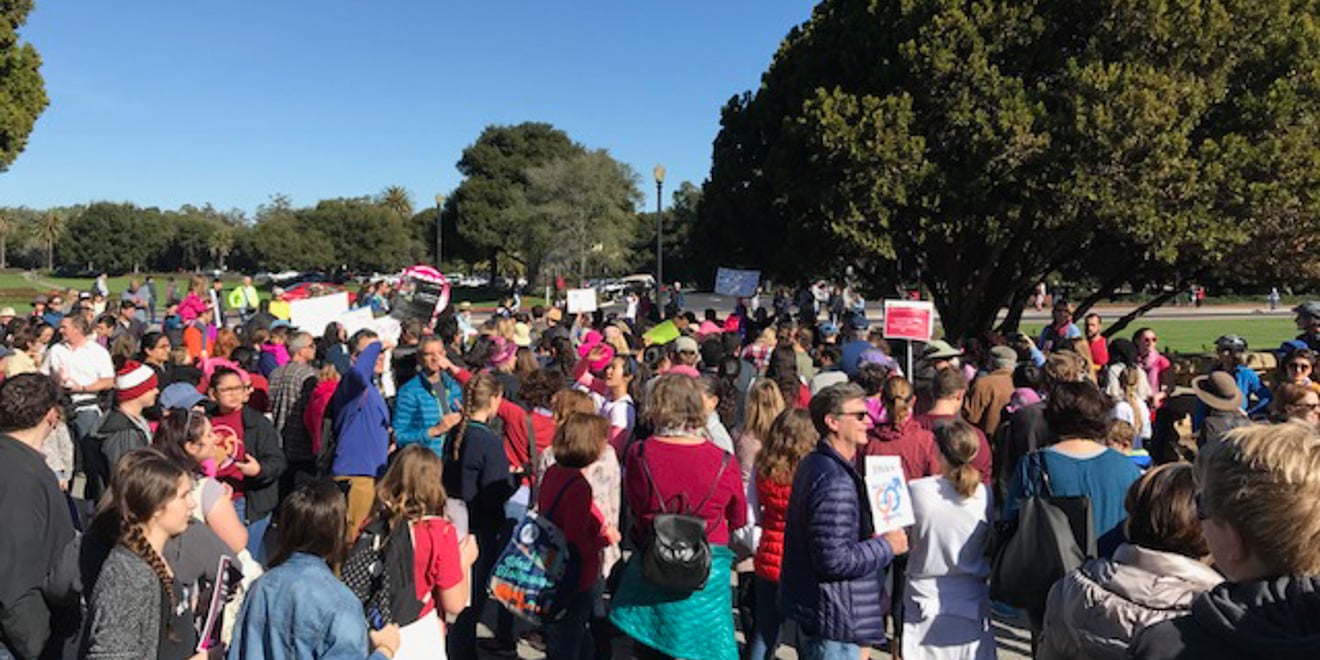Exactly one year after the 2017 Women’s March, where millions protested against the inauguration of President Donald Trump and in support of women’s rights and representation, communities across the nation – including Stanford – continued the tradition by hosting their own marches.
The Stanford Women’s March took place at White Plaza on Saturday in what organizers describe as “solidarity” with the fight for the social and political equality of women and transgender people worldwide. Organized by roommates Chloe Stoddard ’21 and Nivedha Soundappan ’21, the march was planned in conjunction with other Bay Area marches and follows its national counterpart’s theme of “Power to the Polls,” placing an emphasis on representation and voting.
Participants marched around Stanford campus from White Plaza to Meyer Green, where they were met with student speakers and a voter registration area held in collaboration with Stanford in Government (SIG).
The two freshmen behind this year’s Stanford Women’s March saw the event as necessary for multiple reasons.
“I thought about how many students might not be able to make it off campus [to the San Francisco Women’s March] due to scheduling and the cost of transportation,” Stoddard said. “I also thought it was very important to have a march on campus because of the amount of sexual assaults that happen on campuses across the nation, especially in light of the Brock Turner case.”
“We hope to highlight that Stanford stands for equality of all women and [trans people],” Soundappan added.
The march, which was publicized to the Stanford and Bay Area community through posters and social media, drew about 500 participants ranging from students to professors to local community members and their families.
Many marchers saw the event as a way to respond to the state of the U.S. government.
“I’m absolutely appalled at the current direction our government is taking us in,” said Palo Alto resident Linda Clark, who heard about the event through other community members. “We’re stronger than that, and I think that if we advance together, we can actually have an impact.”
“I march because I think we can do better as a country,” said Associate Professor of Medicine Holly Tabor. “I think it’s really important to come out and make a statement and say that out loud. Doing this with other people feels really empowering, and we’re going to have to do more of it in the future.”
Other Stanford students and community members attended the Women’s March in San Francisco; Stanford in Government (SIG) organized transportation for members to attend.
“Creating a culture of civic and political engagement on the Stanford campus is Stanford in Government’s core mission, and events like the Women’s March are an important facet of that engagement,” said SIG Co-Director of Diversity and Outreach Terence Zhao ’19. “We [were] happy to offer our members the opportunity to participate in the Women’s March if they were inclined to do so.”
This year’s marches come as the #MeToo movement highlights women’s rights and sexual assault issues. For Stanford students who hope to participate in the #MeToo discussion on campus, the Women at Work program will host an event with on Tuesday, Jan. 30 from noon to 1 p.m. at the Women’s Community Center. Program Manager Amy Vorro from the Sexual Harassment Policy Office will discuss sexual harassment in the workplace, while SARA’s Coordinator of Prevention Education and Training Grace Poon will focus on working collaboratively to create a culture of consent.
The International Socialist Organization will also host an event on Tuesday, Jan. 23 from 7 to 8:30 p.m. at the Markaz entitled “#MeToo: Fighting Sexism in The Era of Trump.” The group will discuss the “war on women” and how to fight for a world free of sexism.
Contact Felicia Hou at fhou ‘at’ stanford.edu.
